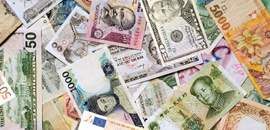- Five months after the COVID-19 pandemic hit the U.S., it is evident the economic downturn was both the most severe and also the shortest in the post-war era.
- Decisive actions by the Federal Reserve and federal government helped contain the fallout. Looking ahead, Fed officials are prepared to keep interest rates near zero for several years, and added federal support is likely.
- The outlook is clouded by the recent spike in U.S. coronavirus cases and lack of a decisive policy response. While the pace of re-openings could slow in some states, we do not expect a debilitating surge that would jeopardize the recovery.
- Adding to the uncertainty is the prospect of a steep decline in second quarter profits and polls that show President Trump trailing Joe Biden by wide margins. Amid this, stock market volatility is likely to stay elevated.
The Markets' Response to the Pandemic
The first half of 2020 will go down as one of the most volatile for financial markets in history. The year opened with the U.S. stock market setting record highs until mid-February, when investors began to take note of coronavirus as it spread from China to other parts of the world. The S&P 500 Index subsequently plummeted by 35% as the lockdown of businesses and social distancing generated the steepest economic decline in post-war history.
Just when investors lost hope, the stock market reversed course on March 23 when the Federal Reserve and the federal government launched a series of actions to limit the fallout. It received an added boost as businesses began to reopen in late April and the unemployment rate fell unexpectedly in May. The S&P 500 Index generated a return of 20.5% in the second quarter, and as of end June the index was down only 3% from its level at the start of the year (Figure 1).
| Stock Market | Jan. 1, 2020 - Mar. 31, 2020 |
Mar. 31, 2020 - Jun. 30, 2020 |
Jan. 1, 2020 - Jun. 30, 2020 |
|---|---|---|---|
| U.S. (S&P 500) | -19.6 | 20.5 | -3.1 |
| Russell 2000* | -30.6 | 25.4 | -13.0 |
| International (EAFE $) | -22.7 | 15.1 | -11.0 |
| Emerging Markets (MSCI $) | -23.6 | 18.1 | -9.7 |
| Bond Market | Jan. 1, 2020 - Mar. 31, 2020 |
Mar. 31, 2020 - Jun. 30, 2020 |
Jan. 1, 2020 - Jun. 30, 2020 |
|---|---|---|---|
| Treasuries | 8.2 | 0.5 | 8.7 |
| IG Credit | -3.1 | 8.2 | 4.8 |
| High Yield | -12.7 | 10.2 | -3.8 |
The U.S. Economy: From Deep Recession to Recovery in Record Time
The coronavirus shock is like no other. When it necessitated lockdowns of businesses and social distancing worldwide, the IMF and other international organizations warned that the global economy was headed for a recession that would be more severe than the 2008-09 financial crisis. While this assessment proved accurate, the good news is the global economy has begun to recover as lockdowns are being phased out.
In the United States, the National Bureau of Economic Research (NBER) announced in early June that a recession had begun in February, ending the longest expansion in U.S. history. Normally, a recession entails consecutive quarters of negative growth, although this is not a formal requirement. Ironically, the recession already appeared to have ended by the time the NBER made its declaration.
The jobs report for May shocked economists and investors, when it showed that 2.5 million jobs had been created and the unemployment rate fell to 13.4%, from 14.7% in April. It was followed by another encouraging report in June, which showed U.S. jobs gains accelerated to 4.8 million while the unemployment rate fell to 11.1%. The two-month cumulative increase in nonfarm payrolls recoups one third of the 22.2 million jobs lost in March and April.
A further sign of recovery was a record jump in consumer spending of 8.2% in May. It raised hopes that federal efforts to support households via one time checks of up to $1,200 for individuals and $2,400 for couples were working. At the same time, the report indicated how far the economy has to go to fully recover, as consumer spending remained down by 12% from February.
Another encouraging development is the rapid growth of the money supply, which increased at an 83% annualized rate for the period from March through May. According to Mickey Levy of Berenberg Capital Markets, it mainly reflects cash hoarding by risk averse businesses and households and the impact of federal support programs to them, as well as Fed balance sheet expansion.1 This development suggests firms and households have ample “dry powder” to tide them over for a while longer.
Uncertainty About the Path of Recovery
For their part, Federal Reserve officials are cautious. As shown below in a chart created by Stephen Cecchetti and Kermit Schoenholtz, the latest forecasts of FOMC members see the economy operating well below its potential over the next two years.2

What weighs on Fed officials is the possibility of a second wave that could hinder the re-opening of businesses. This scenario is not the baseline for the Fed forecasts, but policymakers understand it is difficult to assign probabilities to various outcomes because the circumstances today are completely unprecedented. In the press conference after the FOMC meeting, Chairman Powell emphasized that “We’re not thinking about raising rates. We’re not even thinking about thinking about raising rates.”
Meanwhile, investors are waiting to see what additional steps the federal government will take. Federal programs enacted to tackle COVID-19 currently tally $3.3 trillion and according to the Congressional Budget Office will boost the federal deficit by $2.5 trillion. Congressional Democrats favor additional programs totaling $3 trillion, and President Trump reportedly seeks added measures including a payroll tax cut. However, Mitch McConnell has indicated he will oppose legislation that exceeds $1 trillion. A compromise bill is expected to be enacted later this month, but it is too early to know what it will include.
What Lies Ahead for Markets
Much of the recent gains in the broad market can be attributed to so-called FAANG stocks consisting of Facebook, Amazon, Apple, Netflix, and Google, which now account for a record 23% of the S&P 500 Index. The indicators we follow do not suggest there is deteriorating breadth that typically signals a market top. In this respect, investors appear to be sorting winners and losers from the pandemic, and they are not being “irrationally exuberant.”
That said, the market’s rebound has occurred as S&P 500 profits are declining, and they may not recover fully until late 2021. Upcoming reports for the second quarter should provide an indication of how hard companies were hit by lockdowns. S&P 500 EPS is expected to contract by 44% in the quarter, which is in line with estimates of a steep decline in real GDP.3 Thereafter, Wall Street analysts are looking for profits to increase in the second half of this year but to end 2020 down by 25%, followed by a 30% rebound next year. If so, they will just be back to their levels at the end of 2018. This suggests the recent market rally may be vulnerable to a pullback.
Beyond this, August will mark the period when the 2020 elections swing into full gear as both parties hold their conventions. Joe Biden is expected to run on the themes of improving healthcare, making the tax system more equitable, and promoting greater racial equality. While the stock market has not reacted thus far to polls showing him leading Trump by a wide margin nationally and in key swing states, it is likely to pay closer attention if there are indications that a so-called “blue wave” is likely. The reason: It would likely result in increased tax rates for corporations and the very wealthy.
Investment Implications
Weighing these considerations, our assessment is the worst economic news is likely behind us, and many indicators are improving at a faster rate than was originally expected. While consensus forecasts call for GDP to rebound to pre-virus levels around the end of 2021, a more optimistic outcome is being priced into the stock market and credit markets. Nonetheless, we do not view markets as overvalued based on the improving trend that is underway.
One major uncertainty is how the resurgence in coronavirus cases will affect the pace of re-openings. While it may slow for a while, markets are not expecting a broad-based shutdown such as occurred in March and April, and investors do not doubt the Fed’s commitment to keep interest rates near zero for the next few years.
Another uncertainty is whether corporate profits will recover to the extent investors foresee. In our judgment, it should keep stock market volatility elevated for the remainder of this year and into next.
1 See "Money supply spike: Sources and implications," July 1, 2020.
2 See “The Fed’s Crystal Ball: Looking Beyond The Covid-19 Recession,” Money, Banking and Financial Markets blog, June 15, 2020.
3 See Jonathan Golub, Credit Suisse Securities, July 2, 2020.
*Frank Russell Company (FRC) is the source and owner of the Russell Index data contained or reflected in this material and all trademarks and copyrights related thereto. The presentation may contain confidential information pertaining to FRC and unauthorized use, disclosure, copying, dissemination or redistribution is strictly prohibited. This is a FWIA presentation of the Russell Index data. Frank Russell Company is not responsible for the formatting or configuration of this material or for any inaccuracy in FWIA’s presentation thereof.






















